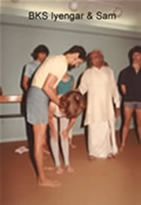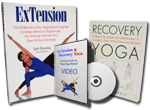 |
Introduction, conclusion:
Although this free online yoga book contains excerpts from both of my previously published books, it substantially differs from them as it explores the following concepts:
- How and why normally healthy people, from beginners to on-going yoga students (regardless of flexibility, strength, and endurance), can use specific neuromuscular principles and laws to maximize their physical, emotional, and spiritual potential while at the very same time, minimize their risk of injury.
- How and why advanced yoga students and highly conditioned athletes of any sport, can use the very same neuromuscular principles and laws to maximize their athletic potential; and at the very same time, how they can minimize their risk of yoga and sports related injury.
- How and why chronically ill, severely injured, dramatically out-of-shape, and aging people must apply the very same principles and laws in order to do yoga without exacerbating pain or irritation; and at the very same time, maximize their healing potential.
The material presented in this project comes from:
-
My extensive study with master teachers in India, Europe, and throughout North America.
-
My extensive study of anatomy, physiology, and kinesiology.
-
And from more than 30 years of personal yoga practice and teaching.
Much of this material has been further refined from:
-
Nearly twenty years as a normally healthy student and a full-time yoga teacher.
-
The extreme of the next six years having chronic illness, severe disability, and clinical depression; all of which caused me to drop out of yoga completely while I struggled with a dramatically changing body and lifestyle.
- And then, emerging from depression and returning to my personal yoga practice and teaching from an entirely different perspective; that of learning how to enhance flexibility, strength, and endurance without pain or strain regardless of anyone's physical ability or age.
Although I am a senior-certified Iyengar Yoga Instructor and have taught at countless schools and centers throughout North America and Europe, I have come to embrace all approaches and disciplines of yoga. For the most part, I honor them all; and in so doing as a westerner "living" in a western body, I like to think of yoga as a system that is designed to:
|
 |
Because this online yoga book focuses primarily upon the human body and upon the exercises of yoga, I invite you to consider this: If the body is a tool of human consciousness, then as goes the body, goes the mind. And likewise, as goes the mind goes the body. Intricately balanced between the two is spirituality; and this is why yoga, when appropriately practiced, can be considered as "meditation in action."
Accordingly, the more physically "out of balance" a person is, the harder it is to relax and quiet the mind ... and to experience a deeper sense of spirituality and meditation that defines the very essence of yoga.
As you navigate through the first chapter of this book, The Mechanics of Yoga, I would like you to consider that this material is based more upon anatomy, physiology, and neuromuscular principles and laws; and less on anyone's opinions or beliefs. All of the material is fully referenced, footnoted, and peer reviewed.
Even so, if you are already a yoga veteran, the concepts and logic presented in this online book may very well challenge your training and notions of how yoga works; especially when I assert that you can substantially enhance your flexibility, strength, and endurance without trying hard. In fact, I'm fond of saying that you can become more flexible, stronger, and create enhanced endurance by hardly trying.
Regardless of your experience, if you are younger than age 32, or if you are older than 48 and have never experienced chronic illness or severe injury, this material will challenge you. The reasons why are discussed in detail in the "Yoga and Aging" chapter that follows.
I do not want you to assume what I offer here is the truth. All I ask is that you read The Mechanics of Yoga chapters, view my free videos, and think about and experiment with its various concepts. Then allow your conclusions to be based upon what I have come to understand are the two most important and fundamental questions that students and teachers can ask: What is yoga? and How does it feel? These two fundamental questions and what they imply are explored in detail in the chapters that follow.
I'd like to repeat that if you are somewhere in your mid 30's or younger... or if you are older your mid 40s to early 50s and have been doing yoga for years, but have experienced limited illness or injury ... you will probably have a difficult time embracing or even agreeing with this material ... at least initially. But resistance changes as you personally begin to practice and apply its logic and principles ... and as you continually ask yourself during both your personal practice and teaching: "What is yoga" and "How does it feel?"
Conclusion:
I have been on both sides of a normally healthy body. Before experiencing my own chronic illness, I felt knowledgeable and confident when I taught yoga to normally healthy students as well as to chronically ill and severely injured people; and for the most part, I know I did good work. However, in retrospect I realize now how little I really knew and how much more I could have given them.
Today, I am again teaching people at all levels, from highly advanced yoga teachers to chronically ill and injured beginning students; but my conceptual understanding, my personal yoga practice, and my teaching has changed dramatically since I developed MS.
After thirty years teaching, I've come to understand what measures success in yoga: It's not what asanas a person can do, but it's the quality of the asana she or he can do that defines a successful practice. Success at any level comes when a student knows the difference between doing yoga and trying to do yoga; for experientially, understanding this difference is considerably more difficult that most practitioners realize.
As I've said before, "doing" vs. "trying" is far more difficult than simply not pushing hard; for I contend that application of the logic and details presented herein, you can substantially enhance your flexibility, strength, and endurance ... not by trying hard, but by learning how to appropriately "do less in order to get more."
If you are a beginner, a seasoned student, or a teacher, my intention and deepest hope is that the material in this online book will encourage you to look at your own personal practice in a new and exciting way. I am not asking you to change your chosen style of yoga, but I am asking you to consider adding a new perspective to the way you currently practice and teach.
As you delve deeper into understanding The Mechanics of Yoga, it's my hope that, if you are a student, this material will help you to maximize your own yoga potential while at the very same time, help you to minimize your risk of injury. And if you are a teacher, I invite you to take these ideas and concepts into your school or studio and share them with your students. The results will speak for itself.
I wish you well
| Introduction Part 1 | Meditation & Yoga |
 |





 Back to top
Back to top